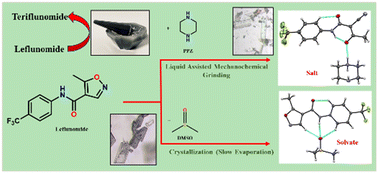Role of mechanochemical synthesis in the crystal chemistry of leflunomide†
Abstract
Mechanochemical synthesis for the formulation of new multicomponent forms of an API involving salts and solvates is considered to be of extreme significance in the field of molecular pharmaceutics. Keeping this in mind, an approach towards the synthesis of a solvate and a salt of the active pharmaceutical ingredient leflunomide (LF) has been developed. The formulation of the salt that emerged via the in situ transformation of the parent prodrug LF to its active metabolite teriflunomide (TF), using solvent-assisted mechanochemical grinding, is reported here. The pharmaceutically accepted additives were selected for the synthesis of new crystalline forms based on the well-established principles of crystal engineering. Here, the formation of two multi-component forms, namely LF_DMSO solvate and TF−_PPZ+ salt with piperazine (PPZ), has been described. These novel multi-component forms so obtained were crystallized and characterized via single-crystal, powder X-ray diffraction and thermal (DSC and HSM) methods. The presence of charge assisted N+–H⋯O− hydrogen bonding interactions along with supporting C–H⋯O/N/F, N–H⋯N, etc. interactions in these forms is well explored in terms of the energetics of the crystal packing. Furthermore, the quantitative interplay of electrostatic, polarization, dispersive, and repulsive contributions towards the interaction energies along with lattice energies for both solvate and salt was carried out using PIXEL, MiCMoS packages and CrystalExplorer.

- This article is part of the themed collection: Introducing the CrystEngComm Advisory Board and their research


 Please wait while we load your content...
Please wait while we load your content...